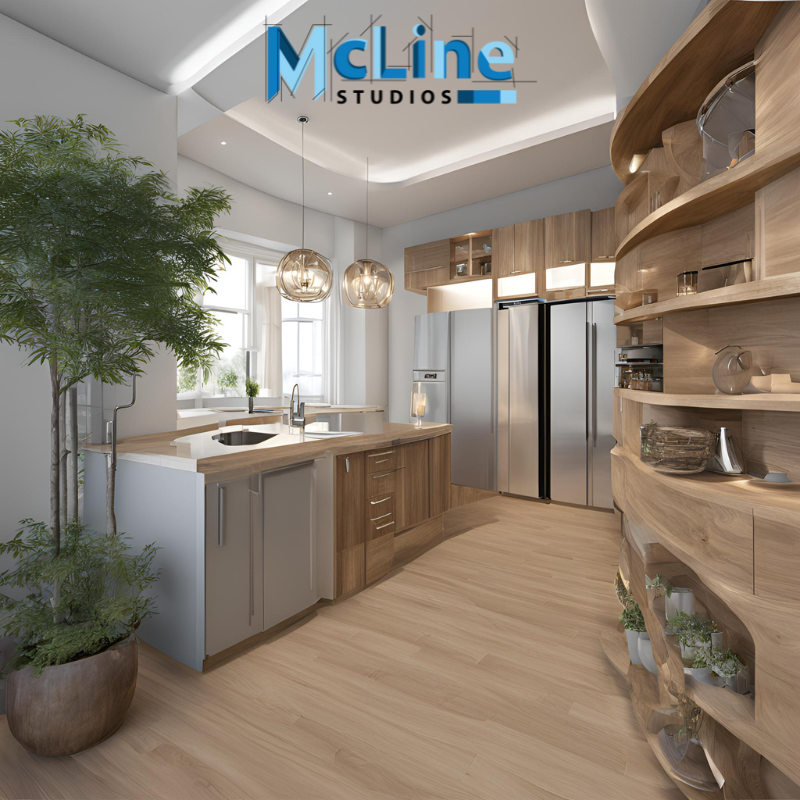Precision and creativity are at the heart of millwork, where every detail matters in creating stunning architectural elements and custom woodwork. CAD (Computer-Aided Design) rendering has become an essential tool in this domain, revolutionizing the way millwork projects are designed and executed.
By providing realistic, three-dimensional visuals, CAD rendering empowers designers and clients to envision the final product with unmatched clarity, well before construction begins.
This technology does more than just showcase designs—it ensures accuracy, enhances collaboration, and streamlines production. From refining intricate patterns in cabinetry to testing materials and finishes virtually, CAD rendering helps eliminate guesswork, reducing costly errors and rework. It has redefined the standards for efficiency and creativity in millwork, helping craftspeople deliver exceptional results.
This article explores the transformative role of CAD rendering in millwork, detailing its benefits and why it is a game-changer for designers, manufacturers, and clients alike.
Whether creating intricate moldings or large-scale custom installations, CAD rendering unlocks the potential to merge artistry with precision.
What is CAD Rendering in Millwork?
CAD rendering in millwork refers to the process of creating realistic, computer-generated images of custom woodwork designs before they are built. CAD, short for Computer-Aided Design, allows designers to bring their millwork ideas to life with accurate details, dimensions, and textures. Rendering adds visual realism to these designs, making it easier to understand how the final product will look and fit into a space.
In millwork, CAD rendering is used to showcase intricate details of cabinetry, moldings, furniture, and other custom woodwork. It captures the grain, finish, and color of the materials, giving clients a true-to-life preview.
For example, a rendering can show how a kitchen cabinet will appear with specific wood types and finishes, or how a custom reception desk will fit within a lobby’s design.
One key benefit of CAD rendering is that it helps improve communication between designers, clients, and manufacturers. Clients can provide feedback on the visuals, ensuring the design meets their expectations before production begins.
Benefits of CAD Rendering in Millwork
CAD rendering has transformed the millwork industry, offering numerous advantages that streamline design, production, and communication. Here are the key benefits of using CAD rendering in millwork:
- Enhanced Visualization
CAD rendering allows designers to create realistic 3D images of millwork designs. Clients can see exactly how their cabinets, furniture, or paneling will look before manufacturing begins. This clarity reduces misunderstandings and helps clients make informed decisions.
- Improved Accuracy
With CAD rendering, every detail of the millwork project is carefully modeled, including dimensions, materials, and finishes. This precision ensures that designs match the client’s vision and that the production process runs smoothly, minimizing errors.
- Better Communication
CAD renderings are a universal language in design. They make it easier for designers, clients, and manufacturers to collaborate. Everyone can see the design and suggest changes if needed, which reduces delays and rework.
- Time and Cost Savings
By identifying potential issues early, CAD rendering saves both time and money. Designers can experiment with different styles and materials without wasting physical resources, ensuring the best outcomes within budget.
- Support for Marketing and Sales
High-quality CAD renderings are excellent tools for marketing. They appealingly showcase millwork designs, helping businesses attract more customers and close deals faster.
Key Applications of CAD Rendering in Millwork
CAD rendering plays a crucial role in the millwork industry by helping professionals visualize designs, enhance project accuracy, and streamline communication. Here are the key applications:
- Design Visualization: CAD rendering brings millwork designs to life with realistic 3D visuals. Clients and designers can see how cabinetry, furniture, or architectural elements will look before production begins. This helps in making informed design decisions.
- Customization: Millwork often involves custom designs. CAD rendering allows for easy adjustments in size, materials, finishes, and colors. It ensures the final design matches the client’s vision.
- Precision and Accuracy: CAD renderings show precise dimensions and details, reducing errors during production. This is essential for creating complex millwork pieces like intricate cabinetry or decorative moldings.
- Effective Communication: Renderings act as a universal language between designers, clients, and manufacturers. Clear visuals minimize misunderstandings and ensure everyone is aligned on the project goals.
- Marketing and Presentations: High-quality CAD renderings are great for showcasing millwork designs in portfolios, catalogs, or presentations. They help businesses attract more clients by demonstrating their expertise.
- Cost Estimation: Renderings allow manufacturers to assess material requirements and production costs accurately, helping to avoid waste and stay within budget.
CAD rendering not only simplifies millwork processes but also elevates the quality of the final product. Its ability to combine creativity with precision makes it a powerful tool in modern millwork.
Challenges in Using CAD Rendering for Millwork
Using CAD rendering for millwork has transformed how designs come to life, but it also brings certain challenges. One major issue is accuracy in detailing. Millwork involves intricate designs, and even a small error in a CAD model can cause problems during production, leading to wasted materials and higher costs.
Another challenge is software complexity. CAD tools have many advanced features that can be overwhelming for beginners. Learning how to use these tools effectively takes time, and mistakes can happen if the designer doesn’t fully understand the software.
Hardware limitations can also pose problems. CAD rendering often requires powerful computers with high processing speeds and ample memory. Without the right equipment, rendering large or detailed millwork projects can be slow, causing delays.
Collaboration can sometimes be tricky, too. Millwork projects often involve multiple teams, such as designers, architects, and manufacturers. If everyone isn’t using compatible software or formats, sharing CAD files can lead to miscommunication or data loss.
Lastly, there’s the issue of costs. High-quality CAD rendering software and necessary upgrades can be expensive, especially for small businesses. Training staff to use the software adds to these costs.
While CAD rendering offers numerous advantages, being aware of these challenges helps professionals find solutions, such as training programs, cloud-based collaboration tools, or outsourcing to experts, ensuring smooth millwork design processes.
The End
CAD rendering has become an indispensable asset in the millwork industry, bridging the gap between artistic vision and technical precision. Its ability to provide realistic visualizations, improve communication, and streamline production processes empowers designers, manufacturers, and clients alike.
By eliminating guesswork and reducing errors, CAD rendering ensures efficiency and cost-effectiveness while enabling unparalleled customization and creativity in millwork projects.
Despite challenges such as software complexity, hardware requirements, and initial costs, the advantages far outweigh the drawbacks. With the right tools, training, and strategies, CAD rendering allows millwork professionals to overcome obstacles and unlock their full potential.
As the industry continues to evolve, embracing CAD rendering not only enhances the quality of millwork projects but also sets new standards for innovation and collaboration, making it a cornerstone of modern design and manufacturing.



